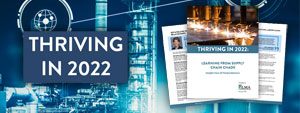
The issue is if we are running hand to mouth, any disruption can create chaos. Clearly, the pandemic created chaos upfront, but it has now become an excuse. It is quite clear that the global supply chain is out of alignment and will not magically realign itself. There are countless partners (links) in your end-to-end supply chain. Typically, each partner has separate goals and conflicting financial objectives. Each partner has different customers, suppliers, transportation partners and trusted advisors. With different parties, different objectives, and different financial incentives, it is obvious blaming our issues on supply chain disruptions is not going to solve the issue.
For example, in order to prepare to be on Good Morning San Diego earlier this week (video will be posted on our website), we did a deep dive into baby formula. Almost every article blamed shortages on the supply chain as out-of-stock rates got to 23% in January 2022, and the recall impacting the Abbott manufacturing plant has shot that number to 40%-50% currently. Certainly, shutting down the Abbott facility would have a significant impact on supply, and it isn’t “flipping a switch” to bring it back online. Prior to this issue, there were packaging shortages and labor shortages. This should not be a surprise as EVERY client is challenged to some degree due to lack of materials and ingredients (at least in terms of extended lead times) as well as labor. The differentiator is how they are handling these issues. The proactive executives have backup plans to the backup plans, are innovative and creative in solving issues, and plan a path forward instead of blaming the issue on supply chain issues.

When Will the Global Supply Chain Realign?
The global supply chain will NOT realign in 2022 or 2023. We shouldn’t keep pushing the date out into the future. With every world event, the situation gets worse. For example, read about the Russia-Ukraine war impacts being spread throughout the world and what you should thinking about to get in front of the impacts.
What are Successful Companies Doing?
Successful executives are taking control of their supply chain. They are getting in touch with their end-to-end supply chain partners, figuring out their capabilities and risks, and taking control of their company’s supply chain. It is not time for inaction and hope. In order to navigate both inflationary and recessionary times simultaneously, you’ll need to get your supply chain in control.
Recently, I talked with the Truckers Network Radio Show on TNCRadio.Live about this issue. We discussed supply chain disruptions, inflation and deflation and what to do about these issues.
What Can Be Done About the Global Supply Chain?
Although this is far harder to solve, we discussed potential ideas on the Truckers Network Radio Show, “Is There a Silver Lining in the Cloud of Confusion in Today’s Supply Chain?” In essence, we should put together an Operation Warp Speed for supply chain and baby formula for that matter. The only way to get so many different parties to agree on a path forward that will provide benefits overall is to get the best and brightest together across industry, government and academia with a focus on innovation and business. Getting business partners to focus on what was needed to be successful with Operation Warp Speed was key to success. Throwing money at the issue alone will not solve it. Of course, business partners will accept funds, but it might actually deter from the overarching objective if the end-to-end supply chain partners are not seeing the big picture and receiving benefits as well. This complex issue with conflicting objectives and financial incentives requires much more!
Please keep us in the loop of your situation and how we can help your organization thrive during these times of volatility and disruption. There will be more winners created than at any other time than since emerging from the Great Depression. To gain additional ideas and insights on how to best navigate these volatile times and thrive, read our new eBook Thriving in 2022. Learning from Supply Chain Chaos. Download your complimentary copy.



